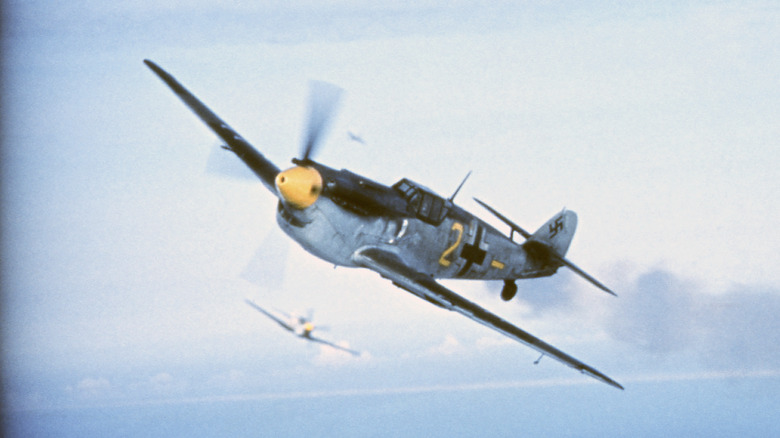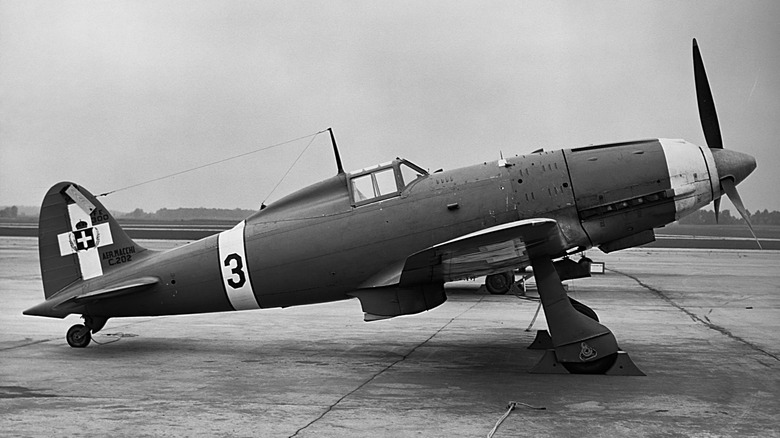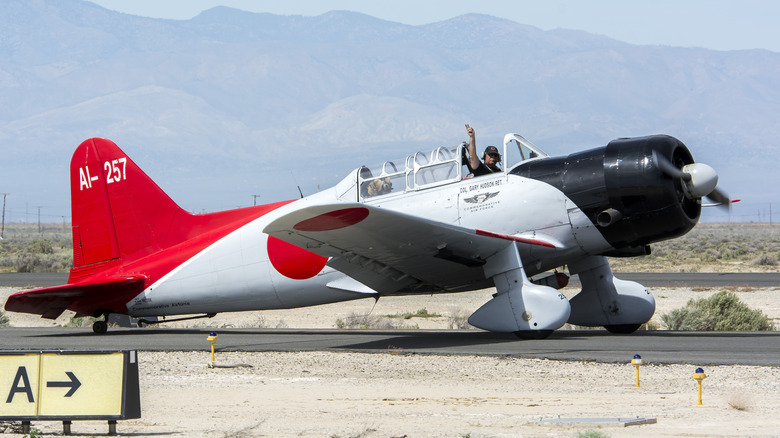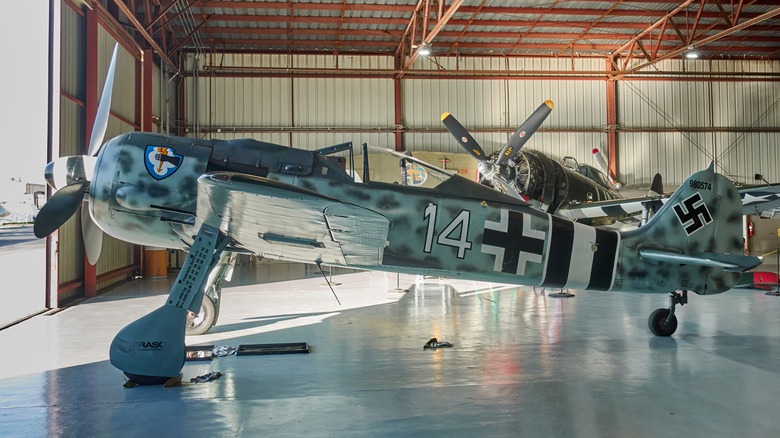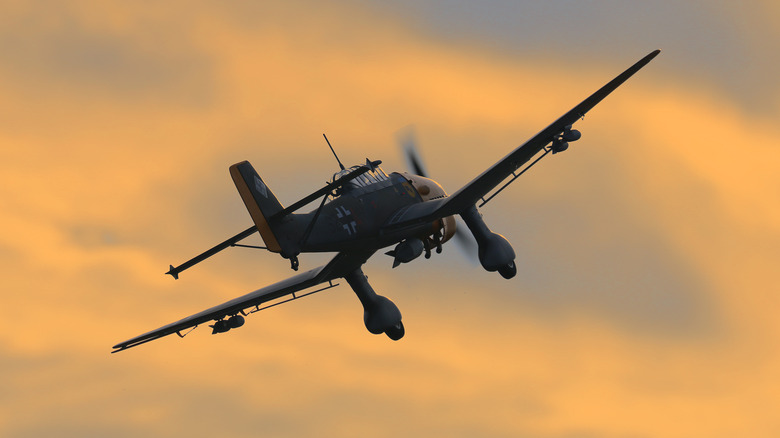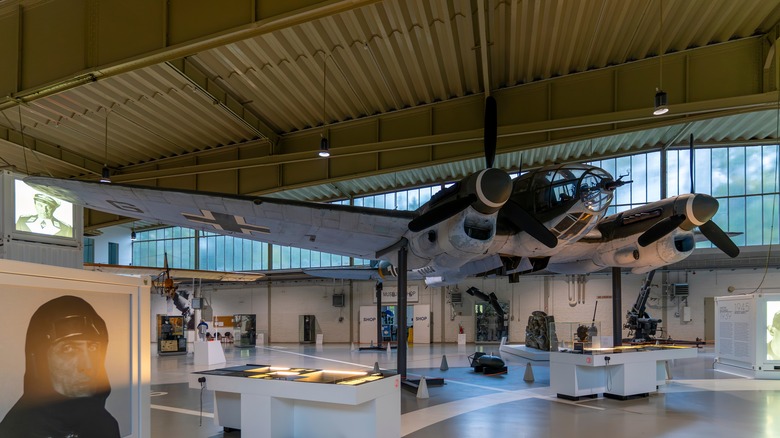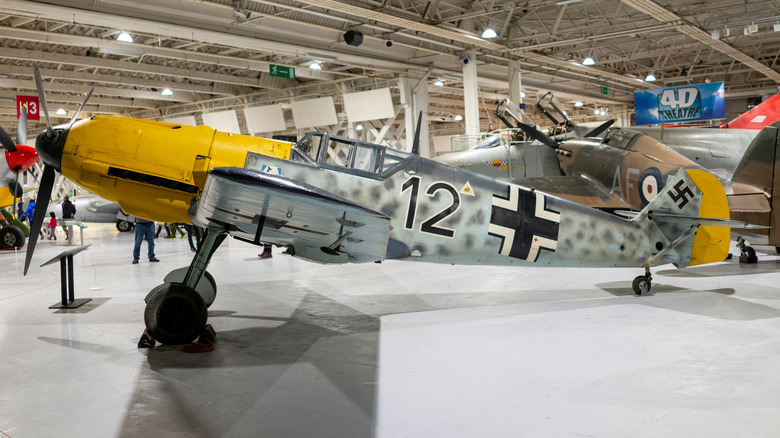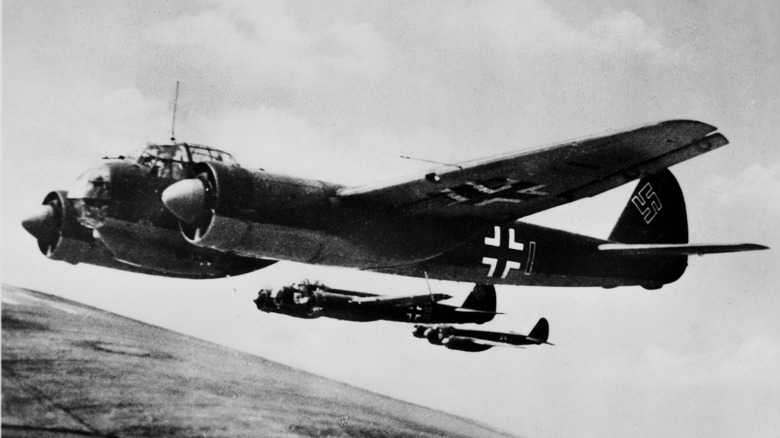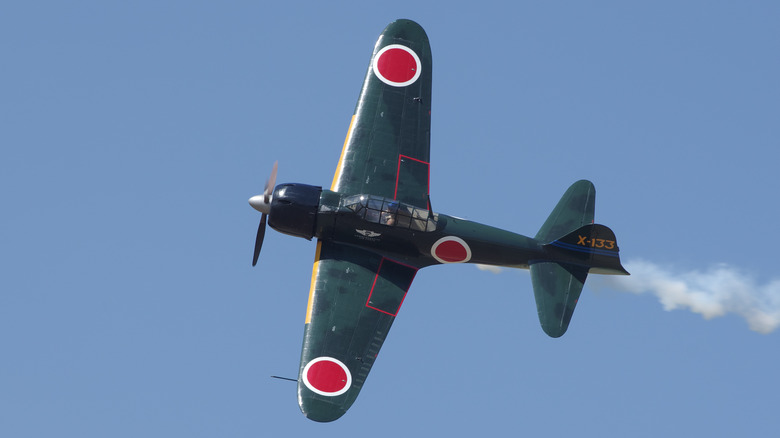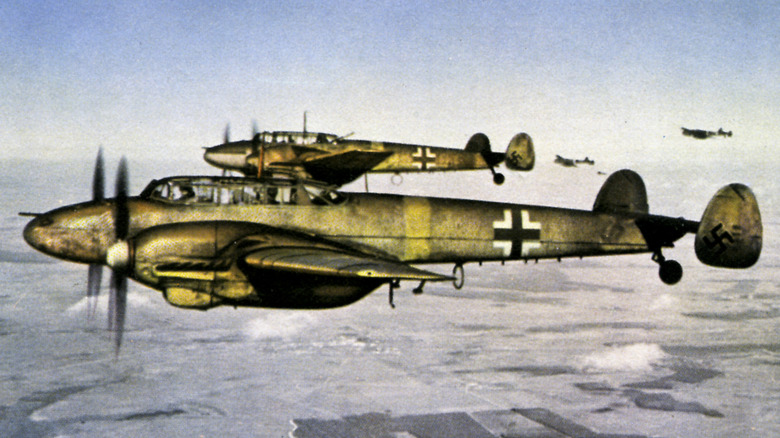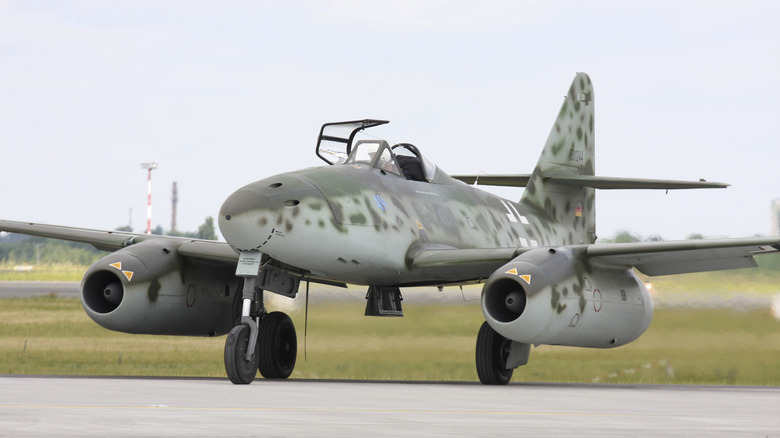10 Iconic Axis Aircraft That Dominated World War II
The Second World War was the most widespread and devastating conflict in human history. It pitted the full might of industrialized nations against each other in an existential battle on sea, air, and land. Aviation had grown exponentially in the interwar years. Though some craft, like the Hawker Hurricane, retained wood and fabric construction, biplanes gave way to monocoque cockpits and metal construction. Enclosed cockpits and increasingly powerful engines boosted aircraft capability in addition to the stress on pilot's bodies. Cannons, rocket pods, and larger banks of machine guns made the craft deadlier.
In every theater, aerial bombing became an integral part of strategy. The Allies and Axis both engaged in massive bombing campaigns. However, bombers were relatively slow and cumbersome, and despite bristling with gun stations, they remained juicy targets for the faster and more maneuverable fighter planes.
Planes like the P-51 Mustang, Supermarine Spitfire, P-47 Thunderbolt, and dozens of others earned their places in history by beating back the aggression of the totalitarian forces arrayed against them. But every hero needs a villain. The Axis powers of Nazi Germany, Imperial Japan, and Fascist Italy sent their own fighters aloft. Many of these machines were no less capable than what the Allied forces fielded. Let's take a look at some of the machines Allied pilots faced in the skies over Europe and the Pacific in the fight to beat back the tide of fascist supremacy.
Macchi C.202 Folgore
The annals of the air war in Europe often overlook the aircraft of the Italian air forces, but the Macchi C.202 Folgore proves that Italy could build a competent war machine. In 1923, the Regia Aeronautica emerged as a distinct air force branch within the Italian military. Like Germany's Luftwaffe, the Regia Aeronautica participated in the Spanish Civil War.
Debuting in 1941, the C.202 did not participate in the war in Spain, but the company behind its construction was founded in 1912. Now known as Aermacchi, the company continues to build combat aircraft, and the C.202 was not the only one it built for World War II.
A Daimler-Benz DB601 engine initially powered a single-seat, low-winged C.202, though Alfa Romeo built licensed copies after Germany began suffering supply issues. The liquid-cooled 12-cylinder made 1,075 horsepower, which propelled the 6,585-pound craft to a maximum speed of 372 mph.
Aermacchi built around 1,500 C.202s between 1941 and 1943. Initially deployed to North Africa, the C.202 outclassed the Hawker Hurricane and P-40 Warhawk but soon withdrew to patrol the Italian theater as the Allies invaded the peninsula. The Germans also used the C.202 in a limited capacity, but it was an Italian craft through and through. Italian aces scored many victories in the C.202, including its top ace, Teresio Martinoli, who died in an air accident in 1944, with a tally of 22 enemy aircraft downed.
Aichi D3A
The air war in the Pacific theater was rife with technical challenges. As an island nation seeking to expand its power over the world's largest ocean, many of Japan's aircraft needed to be capable of operating from aircraft carriers, which had become a military mainstay by the war's outset.
The D3A program began in 1936 to replace the Imperial Navy's increasingly obsolete D1A2 bombers. With a 1,000 horsepower engine and a mono-wing design, the D3A proved to be an enormous improvement over the last generation bi-plane. By August 1942, a more powerful version appeared with a 1,300 horsepower engine.
The Imperial Japanese Navy needed to be able to take out large naval targets. The Aichi D3A "Val" was at the forefront of the mission to cripple the American fleet at Pearl Harbor, where a total of 126 took off from carriers to launch the surprise attack.
Like its American counterpart, the Douglas SBD Dauntless, the D3A carried a crew of two: one pilot and one gunner. Its armament included two forward-facing and one rear-facing 7.7mm machine gun and a 550-pound bomb.
As the primary dive-bomber of the Japanese forces, it saw action in virtually every part of the Pacific theater. The Aichi D3A sank more merchant and naval ships than any other Axis aircraft during the war. They were credited with sinking British carrier HMS Hermes and cruisers HMS Cornwall and HMS Dorsetshire. They also scored three hits on American carrier USS Yorktown at the Battle of Coral Sea.
Focke Wulf 190
Many German pilots considered the FW-190 D the finest aircraft the Luftwaffe put into service. Though the A-8 variant had proven itself an excellent fighter when it entered service in 1941, the D variant earned the 190 its nickname, Butcher Bird (Würger). The shortages of the DB601 engine caused issues, so the FW-190D received a Junkers Jumo 213 in-line piston engine. The result was an aircraft that outperformed Allied fighters until the introduction of the P-51 Mustang and Spitfire Mk.V.
As the Allies advanced further into Europe, FW-190D pilots found that the 1,776 horsepower Junkers engine made the aircraft climb, dive, and run with the Allied fighter escorts. With a maximum speed of 480 mph, it had a cruising speed of 430 mph. The FW-190's primary bite came from a pair of 20mm Mauser Mg-151/20 wing-mounted cannons and another pair of 13mm Rheinmetall MG-131 cannons in the nose.
With improved armor and the ability to carry a 4,000-pound bomb load, later war FW-190F and G models performed in a ground attack role. Manufactured through the war, Germany ultimately produced 20,000 FW-190s of differing variants.
Some of the Luftwaffe's top aces racked up massive amounts of enemy aircraft downed, especially on the Eastern Front, in the cockpit of the FW-190. Only 11 FW-190s exist in museums today, all of which are in the United States.
Junkers Ju 87
The Junkers Ju 87, popularly known as the Stuka, is one of the enduring icons of the Second World War. With its distinctive fixed landing gear and iconic terrifying scream, the "Stuka Siren" has practically become synonymous with bombing. Contrary to popular belief, neither the bomb nor the aircraft itself produced the calamitous wailing. The Luftwaffe attached a "Jericho Trompeten" siren to the landing gear as a method of psychological warfare.
During the Spanish Civil War, the Germans did not let their allied Nationalist pilots near the Stuka, which they considered a secret weapon. After fine-tuning tactics in the Spanish Civil War, the Stuka was one of the first aircraft to see action in World War II. The German government ordered it built as a supplement to its "blitzkrieg" strategy, with the idea being it would serve as a sort of long-range artillery to support mechanized infantry. During the war, the Stuka also saw success attacking Allied shipping.
Initially called the "Sturzkampgglugzeug" ("fighting diving plane" in English), the Stuka could carry a crew of two — pilot and gunner — with a payload of one center-mounted 550-pound bomb and two 110-pound wing-mounted bombs. Removing the rear gunner allowed it to carry a 1,100-pound payload.
The underpowered Stuka met with early success but soon grew outpaced by the accelerating rate of aviation technology. Nonetheless, it retains an outsized presence in the history of the Second World War for its psychological impact on enemy troops.
Heinkel He 111
The air phase of the Second World War revolved around bombing campaigns. World War II was a total war. Each side needed not simply to destroy the enemy but the enemy's means of making war. As a result, infrastructure critical to the war effort became legitimate targets in the eyes of the belligerent air forces, even if it meant shattering entire cities with imprecise bombing.
One of Germany's crucial air actors, the He-111 took part in the Battle of Britain, the Battle of France, and the London Blitz. The medium two-engined bomber was conceptualized as a civilian airliner during the 1930s. After Hitler voided the Treaty of Versailles' statutes against Germany re-arming after World War I, it soon took life as something else entirely.
Heinkel, a legacy aircraft manufacturer that built aircraft during the First World War, flew the first He 111 in Rostock in February 1935. Ultimately, it measured 54 feet long with a wingspan of 75 feet. A pair of Junkers Jumo 12-cylinder engines making 1,350 hp made it capable of carrying a 5,500-pound payload 1,200 miles at speeds of 225 to 260 mph.
Fast and maneuverable, the bomber met with success in the early phases of the war. However, as the German front lines expanded across Europe, they were found wanting due to poor range and aging technology.
Messerschmitt Bf-109
Possibly the most famous Axis aircraft of the war, the Messerschmitt Bf 109 served as the heart of the Luftwaffe's fighter corps. It was the most produced aircraft of Nazi Germany and the second most produced of the war. An estimated 34,000 Bf 109s took to the skies over Europe.
Messerschmitt won the bid for a single-seat fighter that would be easy to produce, repair, and perform well against similar enemy planes. Several variants of the 109 debuted during the war, each more powerful and with better armament than the one before it.
It first flew in 1935, and like many of its brethren in the Luftwaffe, the Spanish Civil War was its testing ground. When the Second World War began, the Bf 109 proved superior to Allied aircraft at low and medium altitudes. It could out-dive and outclimb Spitfires and Hurricanes (except at altitudes above 15,000 feet, where the Spitfire had the edge).
The Bf 109G was the most produced variant. Its DB605 engine produced 1,400 horsepower, and two 12.7 mm machine guns and a 20 mm cannon mounted in the nose made up its armament.
One of the primary drawbacks of the Bf 109 was its small gas tank, which reduced its range. Its maximum range was 620 miles. Compared to the late-war P51, which had a range of 1,600 miles, the Bf 109 could devote far less time to patrolling and fighting than some of its contemporaries.
Junkers Ju 88
The Ju 88 is primarily known as a bomber but was one of the most versatile aircraft in the Axis arsenal during World War II. It served as a dive bomber, traditional bomber, fighter, reconnaissance plane, and ground attack plane.
The prototype Ju 88 made its maiden flight in December 1936. Within a few months, it proved to be a record-breaker capable of traveling over 300 mph. In a move typical of the German High Command, the government demanded that the aircraft also be capable of dive bombing, which resulted in delays in design and production.
The two-engined Ju 88 saw production from 1939 to 1945, with over 15,000 models produced. Though it served in many roles, it had to do extra duty as a bomber after the failure of two proposed bombers, the Heinkel He 177 and Junkers Ju 288. It was also pressed into service as a ground attack fighter after the Henschel Hs 129.
It was equipped with six 7.92mm machine guns and a pair of 1,200 Jumo 211 engines, had a ceiling of 27,880 feet, and weighed 26,700 pounds. It was one of the longest-serving aircraft of the war, taking the place of the He 111 when it began to fall behind in performance.
Mitsubishi A6M2 Zero
In 1937, the Japanese Navy issued requirements for a carrier-based fighter plane. Like any fighter, it needed to be speedy, maneuverable, and have impressive range. Mitsubishi Heavy Industries met the criteria with the A6M2 Type Zero carrier-based fighter plane, known colloquially to its enemies as the "Zero."
The Zero first saw action in the skies over China in the summer of 1940, later a main component at the Pearl Harbor attack. The light and maneuverable aircraft performed well against late interwar aircraft like the P-40 Warhawk. It had a top speed of 350 mph thanks to a 14-cylinder Nakajima Sakae radial engine that made 1,020 horsepower, later upgraded to 1,130 horsepower. Its armament comprised a pair of 7.7mm machine guns and two 20 mm wing-mounted cannons. Aside from being an air-to-air fighter, it could also carry a 132-pound bomb under each wing.
It took Allied aviation until 1943 to field an aircraft that could dance with the Zero. Unfortunately for Japanese pilots, its flight characteristics harbored a fatal flaw. To improve speed and reduce weight, the Zero was tragically underarmored. A well-placed burst of machine gun fire would turn it into a ball of flames. It didn't help that the wing-mounted fuel tanks were beneath the rising sun insignia on the wings, giving American pilots an excellent aiming point.
By the war's end, many of the over 10,000 Zeros had been destroyed, with the bulk of the remainder converted to kamikaze craft.
Messerschmitt Bf 110
The Bf 109's ugly and less famous sibling, the Messerschmitt Bf 110, was first envisioned as a heavy long-range escort fighter. As a twin-engined aircraft, it had plenty of power. Two Daimler-Benz DB 605B twelve-cylinder engines made about 1,400 horsepower each, but the bulky 110 weighed 21,800 pounds with a maximum load. Compared to the Bf 109's maximum takeoff weight of 7,055 pounds, it needed every ounce of power it could get. Despite the heavy load, the 110 could achieve speeds of 311 mph at sea level and 342 mph at altitude.
One of the problems with the Bf 110 lay not in its design but in its deployment. During the Battle of Britain, the Luftwaffe sent the heavy fighters up in daylight raids to tangle with much lighter and more nimble Hurricanes and Spitfires. The Bf 110 squadrons suffered so terribly that they were quickly relegated to night fighter duty, where radar technology helped even the scales.
As a night fighter, the Bf 110 met with more success in the war's later stages, seeing action in the Mediterranean and Soviet theaters. Hampered by poor range, it ironically served best as the Allies closed in on Nazi Germany as it no longer had to fly far to find the fight.
Messerschmitt produced more than 6,000 Bf-110s during the war. Despite respectable production numbers, only two were known to survive unscathed.
Messerschmitt Me 262
Like the Stuka, the Me 262's primary legacy was as a historical icon in the post-war era. As the Allies closed in, Hitler became increasingly obsessed with "miracle weapons" that he believed could stave off his ultimate defeat.
The Me 262 began development as early as 1938, tested with a traditional piston engine before ultimately being equipped with two Junkers Jumo 004 jet engines making 1,980 pounds of thrust each. The Schwalbe or "Swallow" was fast. In a stage of the war during which the dominant Allied fighter, the P51, had a maximum speed of 440 mph, the Swallow could hit 540 mph. Its cruising speed of 460 mph was faster than the Mustang's maximum. But speed isn't everything.
By the time the first Me 262 engaged an enemy aircraft, a British Mosquito over Munich on July 25, 1944, the Third Reich was already reeling. Near complete Allied air dominance combined with a lack of pilots and parts for the Me 262 meant its utility was limited. Despite a production run of nearly 1,400, fewer than 300 went to war. The bulk of the rest were destroyed on the ground.
Perhaps the most significant impact the Me 262 made on history was ushering in the jet age. In the closing days of World War II, the Soviet Union and the United States co-opted the technology to build the air fleets of the future.
